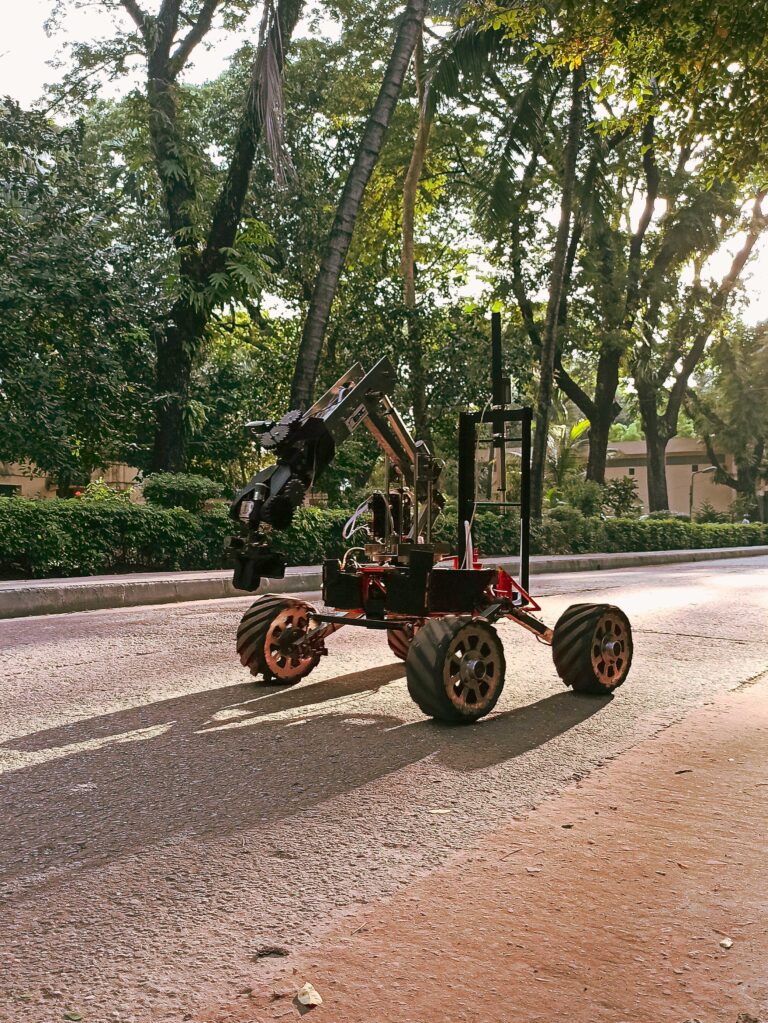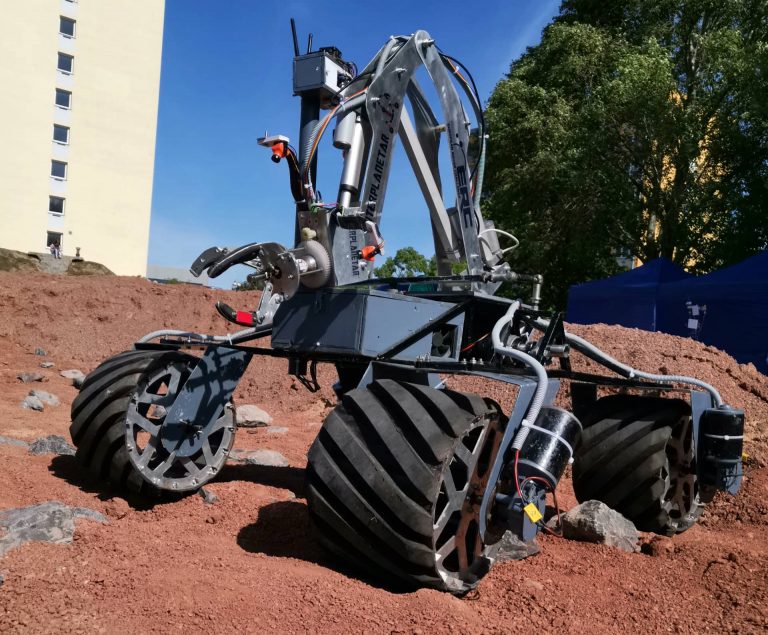With the combined effort of all the team members and experiences gathered from past competitions, we have designed our rover Renaissance V1.0 for University Rover Challenge 2022.
This year the drive system consists of four wheels, each driven by a high torque planetary gear DC motors. These motors are independently controlled by separate BTS drivers. The motors are housed inside the wheel stator to protect it from external damage.
For the suspension system, we implemented a “Bar Differential Mechanism” with a counter-link at the front of the rover. This ensures that when the wheel on the right will go up, the wheel on the left will go down and the body will remain at an average angle between either way. So when the rover goes through rocky terrain, there will be minimum jerking of the body. This suspension system is more lightweight than the six-wheel rocker-bogie mechanism.
We have built a six-degree of freedom rover arm using stainless steel square tubes for better stability and precision. The base of the Rover Arm is located at the center of the body for proper distribution of mass and can rotate 360 degrees on its axis, and a stepper motor with chain-sprocket are used to drive shoulder. A 200mm stroke Linear Actuator is used to move the elbow. A two servo motors is implemented in the lower wrist to achieve precise pitch and yaw mechanism.
We have implemented DC Motor Mechanism in order to get the 360 degree roll motion of the end effector. A worm gear dual shaft DC motor with linear rails is used for the 2-claw gripper mechanism.
Our end effector can tighten a screw, undo a switch, turn a knob. We have attached a poly-fiber at the end of our gripper for better grip and stability.
We improved the strength of our 2-claw gripper system, with which we can pick up a container and transport it to another place, open and close a drawer and insert a cache into the drawer. The whole arm and manipulator is designed and built aligning with the Inverse Kinematics system that our software team is developing.
For the electric system we used four separate PCBs: Wheels, Arm, Science and Power. Each board is used for controlling and monitoring the respective sub-systems. All boards are equipped with Arduino Nano V3.0 for low level control. H bridge 43a BTS drivers and L289N drivers are used for driving the actuators and DC motors.
For the main computer we used a Nvidia Xavier NX. Intel RealSense D435i stereo camera along with a 9 DoF IMU is used for perception during autonomous navigation. ROS is used with a custom made interface for controlling the rover remotely.
The rover is equipped with a 13 dBi high gain Ubiquiti Airmax Omnidirectional antenna while the base station has a 15 dBi high gain Ubiquiti Airmax 120 degree Sector antenna. Both rover and base station uses Ubiquiti Aimax Rocket M2 routers. This communication setup allows us to control the rover for a No LOS (Line of Sight) distance of one and half kilometers.
For in-situ analysis for an on board science mission, we have designed a customized soil collection and chemical analysis kit. Scopper mechanism is used to collect soil samples from the surface which gain vertical motion using two linear actuators. DS5160 60kgcm servo are used for the angular movement of the scooper. The collected soils are poured into a container opening, mixed with water and later carried into the test tubes where chemicals are present in advance.
Presence of lipid, protein, carbohydrate and carbonate biomolecules are examined to determine if the sample consists of extinct, extant or no life. Foxeer fpv camera is used to observe color change after the chemical reactions. Rock samples are analyzed using a digital microscope. RBD-1042 Capacitive soil moisture sensor and DS18B20 Digital thermal probe are used to measure habitability of the soil sample.






